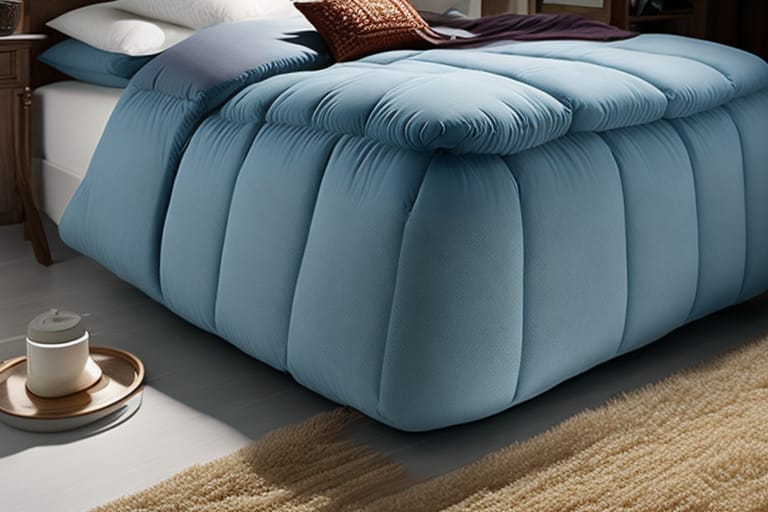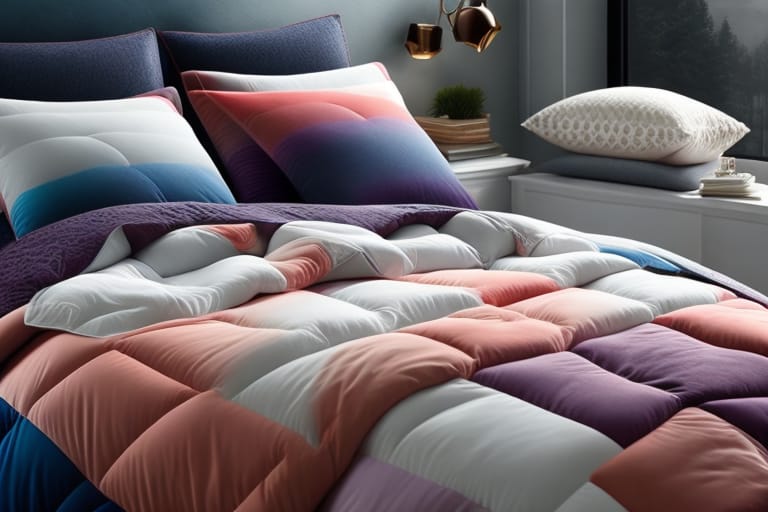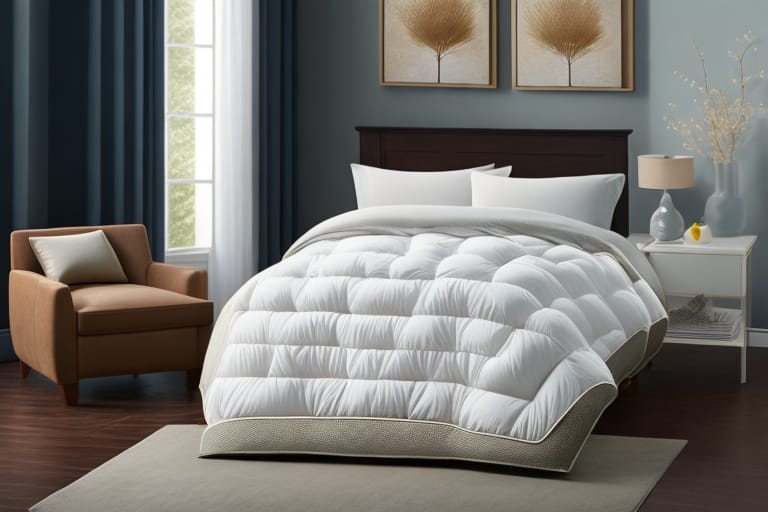When shopping for a down comforter, one of the most important specifications to understand is fill power. But what exactly does fill power mean and why does it matter when choosing a down comforter? This beginner’s guide breaks down everything you need to know about down comforter fill power.
What is Fill Power?
Fill power measures the loft or “fluffiness” of the down cluster. It indicates the cubic inches one ounce of down will occupy when fully lofted and ranges from 300 to 900. The higher the number, the more air pockets the down creates for better insulation and warmth.
Generally, the difference between each 100 matters more at the higher end of the scale. The difference between 550 and 650 fill power is more substantial than the difference between 300 and 400 fill power when it comes to warmth and quality.
Factors Impacting Fill Power
Several factors impact the fill power rating:
- Type of down – Goose down tends to have higher fill power around 600-900 than duck down in the range of 400 to 700. Goose down clusters are larger, creating more loft.
- Size of down cluster – Larger down clusters with more space between plumes create higher fill power and loft.
- Cleanliness – Properly cleaned down has higher fill power. Residual dirt or oil weighs down clusters.
- Bird age and size – Older, larger birds produce higher fill power down.
When down clusters are larger and cleaner, more air gets trapped between the filaments, increasing warmth retention. This is why higher fill powers typically provide more insulation value.
The Relationship Between Fill Power and Other Metrics
Fill Power and Loft
As mentioned above, fill power directly measures loft – the fluffiness arising from down folding into three-dimensional structures.
- Higher fill powers like 800+ can loft nearly double the thickness of lower ones like 500.
- This loft creates pockets of air that prevent heat loss.
So when it comes to warmth, higher fill power means higher loft and better insulation.
Fill Power and Fill Weight
Fill weight refers to the total weight of the down inside the comforter, measured in ounces. Fill power combined with fill weight gives a clearer picture of the down’s warming ability.
For example, an 800 fill power comforter with only 10 oz of fill may be less warm than a 600 fill power one packed with 20 oz of down. The total amount of down plays a key role.
When comparing comforters, consider fill power AND fill weight to determine warmth. Generally a minimum of 400g (14 oz) of fill is recommended for proper insulation.
How Fill Power Impacts Down Comforter Quality and Performance
Warmth
As illustrated above, higher fill powers create more loft and air pockets to prevent heat loss. An 800 fill power comforter can be up to 25% warmer than a 500 fill power one with the same fill weight.
For frigid climates, 800+ fill power goose down provides exceptional warmth without excessive weight. For milder climates, 550-650 fill power should sufficiently insulate.
Durability
The resilience and durability of down improves with higher fill powers. Tightly woven goose down around 600-900 fill power springs back after compression better than lower quality duck down under 400 fill power.
Higher fill down comforters maintain their warming properties and resilience over many years compared to low grade options.
Lightness
The superior loft of higher fill power down creates exceptional warmth with less actual down required. This allows for lighter, more compressible comforters.
For example, Western Mountaineering’s Ultralight comforter provides a warmth rating of -30°F with only 22 oz of 900+ fill power goose down.
Higher fill powers provide unmatched warmth for their light weight. This makes them perfect for backpacking or travelers who need to compress their bedding into small spaces.

Fill Power Recommendations by Climate
Warm Climates
For hot sleepers or tropical/subtropical climates, 300-400 fill power provides sufficient insulation for comfortable sleep. These lower fill powers prevent overheating while still blankets sleepers under breathable pure cotton, linen or Tencel covers
Temperate Climates
In temperate or Mediterranean zones with cooler nights, 550-650 fill power strikes a nice balance between gentle warmth and breathability. Medium fill power options contain enough down to insulate when needed but remain airy when temperatures rise.
Cold Climates
For frigid environments where dropping far below freezing is common, using 800+ fill power goose down provides the highest warmth-to-weight ratio. The exceptionally lofty down creates an insulating cloud able to trap infrared body heat even in extremely cold air. Pair with a tightly woven, high thread count shell to prevent cold air penetration and heat loss through the cover.
Understanding Down Comforter Construction
A comforter’s outer shell plays a critical role in regulating insulation performance. Even ultra high fill power down placed in a poor quality cover will fail to retain warmth.
Here are key construction elements that help keep heat in and cold out:
- Thread count – Fabric woven with higher thread counts have tighter weaves that prevent fill from poking through or cold air from penetrating inside. Look for shell materials with at least 300 thread count.
- Baffle boxes – These fabric dividers segregate down into quilt-like boxes to prevent shifting. well-constructed baffles means even heat distribution.
- Stitching – Tiny goose down clusters can poke out through standard stitching over time. Make sure to select comforters with inverted double or French stitching to contain the down. This also prevents cold spots.

How to Choose the Right Down Comforter Fill Power
Follow this decision checklist when selecting your ideal down comforter fill power:
🔼 Do you live in an exceptionally frigid region with average low temperatures below 20°F (-6°C)? * If yes – choose a comforter with at least 650 to 800+ fill power goose down to guarantee sufficient warmth.
🔼 Is your comforter for year-round daily use? * If yes – pick a mid-range fill power around 600 that provides warmth when needed but avoids overheating.
🔼 Is this for a seldom-used vacation property in mild climates? * If yes – a 300-500 fill power comforter should adequately insulate for intermittent use without breaking the bank.
🔼 Are you looking for a lightweight, compressible backpacking quilt?
* If yes – go with 800+ fill power goose down for unbeatable warmth-to-weight ratio.
Finding your optimal fill power comes down to climate needs and budget. Just don’t compromise too much on quality to save money. An inadequately insulated bed leads to shivering discomfort rather than restful sleep! Carefully balancing fill power and fill weight ensures your comforter keeps you blissfully warm for years.
Frequently Asked Questions
What is the warmest down comforter fill power?
The warmest down comforters have an ultra-high 800-900+ fill power. These create exceptional loft and insulation to retain body heat, keeping you cozy even in frigid temperatures down to -30°F. European white goose down offers the highest warmth, but comes at a premium cost.
What fill power is best for year-round use?
Look for a mid-range 550-650 fill power comforter for versatile three-season use. This moderate warmth prevents overheating in summer yet still insulates during colder weather. Lightweight options work nicely under airy covers.
Why does fill weight matter?
Fill weight indicates the total ounces of down inside the comforter. More fill means more insulation and warmth potential, but also added weight. When comparing options, consider both fill power AND fill weight to find the best balance of warmth and weight for your needs.
How much fill weight do I need?
Most sleep experts recommend a minimum fill weight of 400g (14 oz) for sufficient insulation, especially for year-round use. Increase fill from there if you desire extra coziness and warmth. 700g – 900g is common in premium comforters. Just ensure the shell fabric remains breathable at higher weights.
What’s the benefit of baffle box construction?
Baffle boxes are fabric walls that segment the interior fill into quilt-like sections. This prevents the down from shifting and maintains even warmth distribution. It also reduces cold spots by preventing fill from clumping to the sides over time. Quality baffles enhance durability.
Why does thread count matter in the shell fabric?
Higher thread counts (300+) create tighter woven outer shell fabric preventing tiny down clusters from poking through. This also keeps warm air in and cold air out for better insulation. Ensure the weave remains breathable though for climate control regulation.
How do I care for my down comforter?
To maximize comforter longevity, use a lightweight cover to protect from oils and soils. Dry clean annually using a service familiar with down items. Avoid overly humid storage as moisture damages down. Fluff regularly upon removal from dryer to restore loft and insulation.








